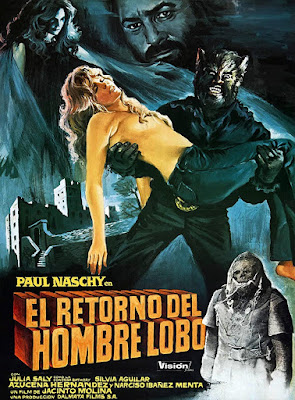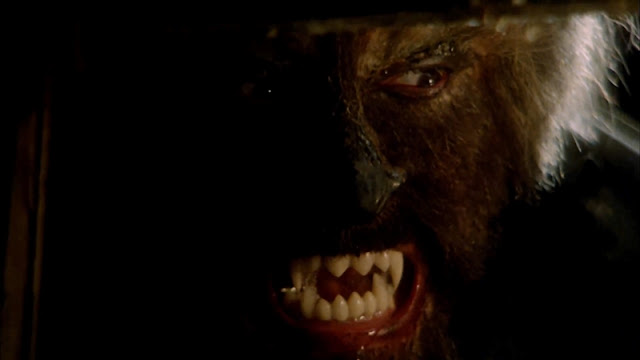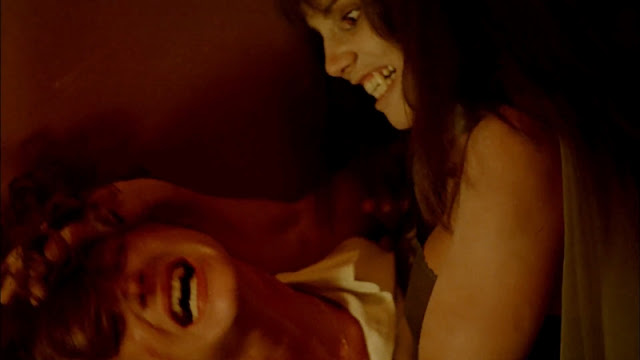(1981) Written and directed by Paul Naschy (as Jacinto Molina); Starring: Paul Naschy, Julia Saly, Silvia Aguilar, Azucena Hernández, Beatriz Elorrieta and Pilar Alcón; Available on Blu-ray (Part of the Paul Naschy Collection) and DVD (Out of Print)
Rating: ***½
“The movies I was making not only reflected my spirit and
personality, but was the result of a series of circumstances that surrounded
the peculiar country of Spain. The Wolf Man created by the English or
Americans, like Larry Talbot, had nothing to do with Spanish culture. I guess
that’s why my fans are people who know my movies and have been subconsciously
affected by all of this, by a very special country that has always been in
conflict, which is Spain. This is reflected in my work.” – Paul Naschy (excerpted
from a 2002 interview)
Over the course of his career, Paul Naschy* earned a well-deserved reputation as the Spanish Lon Chaney, portraying a variety of boogeymen, including Dracula, Frankenstein’s monster, the mummy, and of course, a werewolf. Arguably his best-known character was the eternally doomed Polish nobleman/lycanthrope Waldemar Daninsky (a role he played 12 times). ** The Night of the Werewolf (aka: El Retorno del Hombre Lobo) represented a return to familiar territory, blending old-fashioned Hammer-style gothic atmosphere and pools of blood, with a sprinkling of sex and nudity* for good measure.
* Fun Fact #1: Jacinto Molina adopted the moniker “Paul Naschy,” in an effort to make his name more marketable to international audiences. According to the prolific actor/filmmaker he chose “Paul” after seeing a picture of Pope Paul VI in a newspaper, and the surname “Naschy” was based on Hungarian weightlifter, Imre Nagy.
** Fun Fact #2: By comparison Lon Chaney Jr. only played his signature role, Lawrence Talbot (aka: The Wolf Man), five times.
*** Fun Fact #3: According to Naschy, horror filmmakers were
allowed to slip by the persnickety Spanish censors, provided all of the
supernatural mayhem took place in a different country.
In the film’s prologue, set in 16th Century Hungary, we witness a tribunal, where Countess Elizabeth Báthory (Julia Saly) and her confederates are punished for their sadistic crimes against humanity. Compared to her cohorts, Báthory receives a veritable slap on the wrist, confined to her chambers for the rest of her life, while her accomplices are sentenced to death. Most notable among the doomed, is Polish nobleman Waldemar Daninsky (Paul Naschy),* who moonlights as a werewolf (under the control of Báthory, he preyed on hundreds of villagers). But (Surprise!) death isn’t the end for Báthory and her troublesome troupe. Skip forward several centuries, when diligent archeology student Erika (Silvia Aguilar) is hot on the trail of the site that houses Báthory’s not-so-final resting place. Erika, whose ambition is only matched by her ruthlessness, strangles her mentor (Narciso Ibáñez Menta) and takes his amulet, which holds the key to bringing the evil countess back to life. Meanwhile, a wealthy collector and his lackey unwittingly bring Daninsky back to life by removing a silver cross from his chest. If Erika’s previous exploits weren’t enough to convince you of her malevolent intentions, she brings along two of her nubile colleagues, Barbara (Pilar Alcón) and Karen (Azucena Hernández), just so she can sacrifice them. Proving how cutthroat the field of archeology can be, Erika suspends Barbara’s body above Báthory’s crypt, puncturing her neck. In return for Erika’s loyalty, the newly revived Báthory bites her number one fan in the neck, adding her to the ranks of the undead.
* Fun Fact #4: Unlike Elizabeth Báthory,
don’t bother searching for Waldemar Daninsky in the history books. Naschy
derived his venerable character’s name from Polish weightlifting champion Waldemar
Baszanowski.
Since Naschy is the star of the movie, we’ll conveniently
forget about all those murders that occurred several hundred years ago, so he
can emerge as the nominal hero. In an early scene, he comes to Erika and her
friends’ rescue when they’re ambushed and assaulted by bandits. 300 years of
slumber haven’t dulled Daninsky’s impulse to settle the score with Báthory and stop
her growing league of vampire minions. To reinforce Daninsky as a sympathetic character,
there’s a brief poignant moment (paralleling a shot in Jean Cocteau’s Beauty
and the Beast) in which the werewolf regards his reflection in a pool of
water with contempt. Karen plays Beauty to Naschy’s Beast, whose unconditional
love for Daninsky can set him free.
Julia Saly seems to be having a blast as Elizabeth Báthory, and why not? Along with her vampire henchwomen, she’s a formidable opponent for Daninsky – a force of nature to be reckoned with. Compared to Báthory, goody-two-shoes Karen couldn’t be anything but bland. The closest thing to a tragic figure is Mircalla (Beatriz Elorrieta), Daninsky’s live-in caretaker. Although persecuted by the villagers as a witch (half of Mircalla’s body is horribly scarred from an attempt to burn her), she’s a force of good, protecting her benefactor and Karen from harm. She scarcely hides the fact that she’s also in love with Daninsky, but no thanks to her hideous appearance, she remains squarely entrenched in the friend zone (Yeah, so much for “It’s what’s inside that counts.”).
Despite some creaky elements, recycled from countless other monster movies, The Night of the Werewolf never fails to entertain. It’s the equivalent of cinematic comfort food, packed with the usual trappings we’ve come to expect from modern gothic horror: a tortured protagonist, a shadowy castle shrouded in fog, comely women clad in diaphanous nightgowns (carrying an unwieldly candelabra, no less). If one ignored the movie’s origins, it could almost be confused with a Hammer production (if Hammer played fast and loose with their properties). It’s an irresistible blend of trashy and sublime that hooks you in from the first reel. Who wouldn’t want to see Elizabeth Bathory and her vampire horde versus a werewolf, in a struggle for ultimate power? It’s the historical smackdown we so richly deserved, if reality hadn’t denied us.
Sources: “Paul Naschy: Interview with the Werewolf,” 2002
Blue Underground interview;
Paul Naschy wiki







Fun and funny review, barry!
ReplyDeleteWho knew being an archaeologist could be so dangerous! Lol
I feel guilty that I've never heard of the night of the werewolf or Paul Naschy but thanks to your review, now I have!
Thanks so much, John! I guess archaeology is not without its hazards - Just ask Indiana Jones!
DeleteIt's never too late to discover a new favorite. I have a lot of Paul Naschy films to catch up with, but this is a good place to start. ;)
1981 was a very good year for werewolves, what with The Howling and An American Werewolf in London coming out, and Naschy's film serving as a retro counterpoint to those updates to the genre. I too have a lot of catching up to do with Naschy films. I've seen Horror Rises from the Tomb (just okay), Count Dracula's Great Love (great fun), and The Hunchback of the Morgue (has to be seen to be believed!). It sounds like Night of the Werewolf, with Waldemar going up against Elizabeth Bathory as a vampire queen, is great, cheesy fun!
ReplyDeleteIf you're looking for good cheesy fun, this will certainly scratch that itch. It's a throwback, in the best way. I need to see Count Dracula's Great Love and The Hunchback of the Morgue (just for the name alone)! I can't believe I forgot that those Howling and American Werewolf also came out in 1981. What a year, indeed!
DeleteThis comment has been removed by a blog administrator.
ReplyDelete